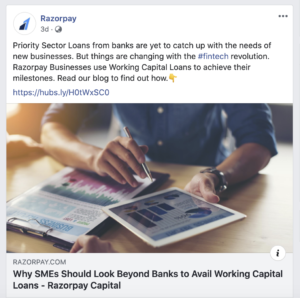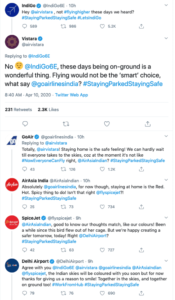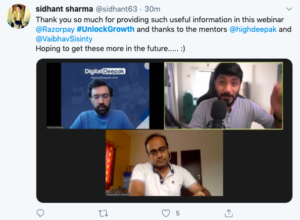In the past one week, I have followed a company on LinkedIn because of its fantastic HR policies, ordered a basket of baked goods because of targeted Instagram advertisements and tweeted to a leading OTT platform because it wanted “wrong answers only”. This is just a small example of how social media marketing has entered our lives.
Table of Contents
What is social media marketing?
Social media marketing is the process of promoting and displaying your brand, culture and offerings to audiences on various social media platforms with the help of specially curated content.
Digital Marketing Institute says that 92% of marketers believe that social media has helped them increase their exposure. Brandwatch has concluded that around 91% of retail brands are on two or more platforms. Not to forget, almost 81% of SMEs use some form of social media to promote their business.
The bottom line is there lies an enormous opportunity in social media which can reveal itself to you and your business if tapped correctly.
Types of social media platforms
Though social media platforms have been around for more than a decade, their importance has increased drastically in recent times. This makes it difficult for businesses to decide where they should be present and what kind of content and campaigns they should be running.
Let’s get one thing straight: not all platforms are meant for all businesses and not all content can be used on all platforms. Every platform has its strengths and weaknesses, suitable content formats and some core objectives, based on which, we can classify them into three categories:
- Social Networking Platforms: Facebook, LinkedIn, Twitter
- Media Sharing Platforms: Instagram, YouTube, Snapchat
- Discussion Forums: Quora, Reddit
You might often feel that the lines of differences between these platforms tend to blur, but at the core, their primary function is what makes them different from one another. In this article, we will discuss the most primary of social media platforms which also account for the most extensive cumulative user base – ‘Social Networks’.
Social networking platforms: Connecting customers
Social Networks are amazing places where brands and customers can co-exist, enabling both parties to understand each other better. They allow you to achieve the following objectives:
- Market Research: Since these networks enable a one-to-one relationship between a brand and its customers, it allows the former to gauge the customer’s expectations and feedback and thus, take necessary actions.
- Brand Awareness: Thanks to their broad reach and audience base, businesses can use targeted advertising on social networks to let the audiences know about their products and services.
- Relationship Building: Possibly, the most significant advantage of social networking is that it helps customers to personify the brands they love. The kind of content you choose to share here can form opinions about your brand values and brand tones which can positively influence your existing and potential customers.
- Customer Service: With social media, customers have the power to let the brand and the world know about their experience with the product or service. Thus, many companies have converted their Facebook and Twitter pages into real-time customer service centres where all queries are addressed and reverted to, within minutes.
Apart from this, each social networking platform has its specific strengths, features and content formats. Let’s try to understand each one in detail.
Understanding social networking platforms: Facebook
Being one of the oldest social media platforms from the current mix, Facebook boasts of 2.4 billion users around the globe. Here are some impressive statistics regarding Facebook:
[bctt tweet=”According to the State of Social Media Report 2019, 93.7% of businesses are present on Facebook, which is the highest amongst any social media platform.” username=”razorpay”]
- According to the State of Social Media Report 2019, 93.7% of businesses are present on Facebook, which is the highest amongst any social media platform.
- 27.9% of the Indian population is currently on Facebook.
- The highest demographic of Facebook users is constituted by males and females who are between 25-34 years of age – essentially Millennials.
- The male population on Facebook is 75%, with females comprising 25% of the user base.
Successful content formats on Facebook for social networking
From the days of status updates and likes, Facebook has evolved to the stage of live videos and reactions. With constant change and growing customers, we researched the content formats that work the best on Facebook, so you don’t have to.
Videos
It is the human tendency to react more strongly and positively to visual stories than to written words. Targeted right, video content can instantly help you form a bond with the customer, which might convert to actionable results down the road.
According to a study, the algorithm of Facebook favours video content over written posts. Today, companies are using videos to showcase their products, make promotional announcements, cover customer stories and of course, launch brand campaigns.
Linked content post
Linked content posts, as the name indicates, are Facebook posts which are linked to content pieces outside of the platform. As soon as you paste the link in the status window, Facebook automatically adds the meta-description and the image, making it very attractive for sharing purposes. This type of content has proven to have had a higher success and engagement rate as compared to normal typed out statuses, but a lesser rate than images and videos.
 Razorpay has two long-format properties – Blog and Learn – where we regularly post blogs, articles and listicles to help educate our customers and prospects. We religiously post the linked content on Facebook, which has given us two-fold results: it not only drives the desired traffic to our blog pages but also provides essential information for our Facebook followers.
Razorpay has two long-format properties – Blog and Learn – where we regularly post blogs, articles and listicles to help educate our customers and prospects. We religiously post the linked content on Facebook, which has given us two-fold results: it not only drives the desired traffic to our blog pages but also provides essential information for our Facebook followers.
FB live
In 2016, Facebook debuted its FB Live feature wherein brand pages or personal profiles could directly stream video for their audience, enabling live interaction between the presenters and the viewers. Facebook was one of the first social media platforms to bring the Live feature onboard and those who understood it well in the start reaped its benefits.
According to AdWeek, Facebook Live videos get almost thrice the amount of engagement as compared to a non-live video. Not just this, they also beat standard image posts to receive 5x more traction and engagement. It is a great way to ensure real-time participation – in the form of Q&A sessions, reactions and feedback.
Here are some of the brands which have utilised the Facebook Live feature in diverse ways:
- Start-ups like Forever Living and YourStory have been streaming live sessions featuring their founders and special guests to discuss topics related to their respective industries.

- Tapping on a contextual problem, JioSaavn organised an FB Live session to help artists find alternate ways of generating revenue amidst the lockdown when the sector was severely hit.
- Government and regional institutions have also come up with pathbreaking ways to address their problems. After a suicide tragedy struck the Churu region in Rajasthan, the police in the area decided to boost the morale of their residents by organising Live sessions with motivational speakers, artists and celebrities.
Understanding social networking platforms: LinkedIn
The Microsoft-owned social networking platform, LinkedIn, is characterised by its professional-first feel and approach. Today, LinkedIn is the penultimate platform for everything profession related, from jobs and companies to industry updates and business networking.
Here are some salient statistics regarding LinkedIn:
- India is the second-largest market for LinkedIn, with a whopping 62 million users.
- 25% of the total users have spiked in the last 18 months.
- Compared to Facebook, which has around 70% of its Indian user base between 18-34 years of age, LinkedIn has 90% of its members below 34 years of age.
Successful content formats on LinkedIn for social networking
LinkedIn’s social networking aspect comes from the fact that it helps professionals to come together and connect, implying that the tone of the platform is formal and informative. Thus, you will notice that the content formats that work on it also carry the same characteristics.
Company stories
LinkedIn can be considered a perfect platform for company PR. Since many users are job seekers, they often keep out a keen eye for prospective companies and policies. Whether you are a growing brand or an established company, this is the right time for you to communicate your story to the professionals on LinkedIn.
The communication can be in the form of employee stories, company culture, company’s journey from inception to success, groundbreaking policies and fun events.
Google’s LinkedIn page frequently talks about the experiences of employees working at Google and their achievements, making it attractive for prospects and motivating for existing employees.
Blog posts
LinkedIn is one platform where people are interested in reading long-format content since they actively seek technical, industry-based or career-enhancing advice and information.
- LinkedIn’s post feature allows you to write up to 1300 characters which are most apt for readability purposes.
- If you wish to write an even longer blog post, do use the Publisher option on LinkedIn, which allows you to write more than 100,000 characters.
- You can also link an article on Medium, WordPress or any personal website by simply pasting the link in the status update box. LinkedIn will optimise it for sharing purposes by adding a meta-description and image.
 The content about blog posts, as discussed above, should have a professional undertone. Most of the successful blog posts revolve around topics like career journey, career-enhancing tips, interview experiences, digital marketing, current industry updates and marketing hacks. But that does not mean you cannot experiment with your content. The key lies in judging your network and connections.
The content about blog posts, as discussed above, should have a professional undertone. Most of the successful blog posts revolve around topics like career journey, career-enhancing tips, interview experiences, digital marketing, current industry updates and marketing hacks. But that does not mean you cannot experiment with your content. The key lies in judging your network and connections.
Company leaders as influencers
LinkedIn influencers can be called as Key Opinion Leaders who are experts in their fields, posting content and propagating ideas that usually revolve around some dedicated topics. Herein lies an exciting opportunity for companies, start-ups and brands. The leadership, especially top management of companies including CEOs, Founders, MDs and Chief Managers – can turn their LinkedIn personal profiles into influencer hubs.
The art here is to establish yourself as an influencer so well that your followers soon start associating the same credibility and trust with your company or start-up. Shantanu Deshpande, the founder of the Bombay Shaving Company, is an excellent example of this kind of influencer leadership. He is a thought leader in the area of start-ups and business lessons, so you will often find him posting about the same. Deshpande’s credibility and knowledge are established so well now that people feel comfortable replicating the same values to the company he founded.
Photo updates
Photos help give your brand a unique identity and a personality, which in turn allows followers to connect instantly to what is happening at the ground level. LinkedIn discovered that visual media results in a 98% higher comment rate and YouTube links that play automatically in feed have a 75% higher share rate.
[bctt tweet=” LinkedIn discovered that visual media results in a 98% higher comment rate and YouTube links that play automatically in feed have a 75% higher share rate. ” username=”razorpay”]
Photo updates can revolve around any significant events that your company organised, employee gatherings and outings, achievements at award ceremonies and in-office celebrations. In the COVID era, companies have started sharing photos and videos narrating the New Normal like showcasing work-from-home desks, Zoom call screenshots and webinars.
Understanding social networking platforms: Twitter
Twitter is a one of its kind platform, which has risen to immense popularity and introduced game-changing formats in the social network sphere. Started in 2006, Twitter’s competitive edge comes from the fact that it levies a limit of 280 characters (earlier it was 140) to deliver your content.
Here are some critical facts regarding Twitter in India:
- India is the third-largest user base for Twitter in the world, with more than 35 million users.
- 40% of Twitter users lie in the age bracket of 18-29 years of age, making it a relatively young platform.
- In India, Twitter has become a home ground for online discussions, news and trending topics. It is also increasingly becoming a platform where people can connect and engage with brands, companies and government agencies.
Successful content formats on Twitter for social networking
News and contextual commentary
[bctt tweet=” According to a survey, 40% of Twitter users rely on the platform to keep up with trending news, while 39% use Twitter to keep a track on the news in general.” username=”razorpay”]
According to a survey, 40% of Twitter users rely on the platform to keep up with trending news. Apart from that, almost 39% use Twitter to keep a track on the news in general. If you are a brand or a company which wants to engage with users effectively, do latch on to contextual content. This can be trending news items and currently popular topics, which match the tone of your brand.
Some of the formats which are used by brands for contextual commentary are:
- Impact of Trending News on Business: Brands which are pioneers in a particular field can explain the news to give more in-depth insights. For example, Delhi Metro Rail Corporation explaining the implications of Lockdown on their services.
- Trending Hashtags: Whenever a big news item takes centre stage, Twitter will usually have a trending hashtag to follow it. Some brands use the same hashtag to become a part of the trend.
- Puns and Funny Commentary: Brands like Zomato and Durex are pioneers for churning out entertaining content revolving around trending news items.
Brand personality campaigns for social networking platforms
Twitter is one of the most effective platforms for brands to personify themselves. Every brand wants to follow a brand tone – it can be fun and quirky like Dunzo or sweet and heartwarming like Amul. You can communicate the same to your followers by curating content around the tone you want to go for. Here are some ways to do this:
- Interact With Your Customers: Try to reduce the gap between you and your customers by addressing their queries and replying to their requests. A great example of this is Spotify. A Twitter user pointed out to Spotify that their logo looks like Britannia Good Day biscuits. In no time, they changed their profile picture to the biscuit image.
- Interact With Other Brands: The market today is competitive, but once in a while, you must engage in fun banter with your competitor brands. Your customers are bound to see this sportsmanship in a lovable light. During the lockdown when air services were kept on hold, major Indian airlines came together on Twitter to uplift each other through the troubled times.
 Polls
Polls
Polls are an effective way to ensure both consumer engagement and market research. Brands use polls on Twitter to gauge customer sentiment, get feedback on their offerings and determine the needs of the customers.
Airbnb, Marvel Entertainment and Amazon are some brands which run useful polls on their Twitter handles.
- Formulating Trending Campaigns
If used effectively and thoughtfully, a brand-led hashtag can very well turn into a national or global trending campaign. One way is to track a prevalent, current issue and formulate your campaign around it. For example, when Delhi’s AQI index was beyond miserable last year, Uber launched a campaign called #LowerTheWindow. In this campaign, they asked people to suggest tips to move Delhi towards a cleaner future.
 The other way is to make something which has the potential of going viral because it clicks with the audience. Last week, Razorpay launched a webinar-cum-campaign called #UnlockGrowth which was followed keenly by the viewers. With more than 8000 attendees, it became one of the Top 20 trending hashtags on Twitter.
The other way is to make something which has the potential of going viral because it clicks with the audience. Last week, Razorpay launched a webinar-cum-campaign called #UnlockGrowth which was followed keenly by the viewers. With more than 8000 attendees, it became one of the Top 20 trending hashtags on Twitter.
The perfect social networking platform for you
The choice of which social networking platform you want your brand to be present on should depend on three factors:

- Goals: Before you undertake social media marketing in any form, be clear about what you want to achieve through it. Refer to the list below to know about some of the most crucial marketing objectives and which platforms help you accomplish the same.
| Features | |||
| Market Research | Yes |
– |
– |
| Building Brand Personality/Brand Image |
– |
Yes | Yes |
| Brand Awareness | Yes |
– |
Yes |
| Customer Service | Yes |
– |
Yes |
| Company Culture |
– |
Yes |
– |
| Media and Blog Sharing | Yes | Yes |
– |
| Relationship Building |
– |
Yes | Yes |
Also read: Social Media Marketing for Businesses: Decoding Media Sharing Platforms
- Audience: All your marketing efforts are meaningless if the audiences are not aligned. Before you choose any platform, you must perform a thorough check on the demographics and psychographics of the audience. For example, if you want to communicate with graduates between the age of 20-25, then LinkedIn is a better bet. On the other hand, if you are looking to target homemakers in their 40s, then Facebook will be more suited.
- Capabilities: It is vital to judge and ascertain your in-house capabilities and budgets before narrowing down on social networking platforms. Video content might work well on Facebook and LinkedIn but producing high-quality videos requires good scripts, producers and more. Thus, every suitable format is not meant for every company.
Thus, the platform you choose should be at the confluence of the three factors mentioned above. As a thumb rule: “The platform where my target audience is the most active and thus, allows me to achieve my marketing goals within my budget and capabilities is the platform I should go for.”
Managing your social networking platforms
Once you have finalised your social networking platforms, the next steps are to curate, publish and monitor your content pieces. There are three main steps in managing your social networking accounts:
Creating content
After choosing viable content formats, you have to start creating posts or videos as per the requirements. Websites like Canva and Crello provide free templates for various types of content including posters, videos, reports, banners and thumbnails.
Publishing your content
There are specific websites on the internet that can help you publish and track your content. This includes scheduling posts, formulating content calendars, enhancing content and optimizing the current strategy. Websites like Sproutsocial, Buffer and HootSuite provide good publishing and tracking tools which deliver excellent results.
Analysing and monitoring your content
Once your post is live, the next thing you need to focus on is the reception of your content. This is done by analyzing metrics which tell you how audiences are responding to your content. If the parameters are reasonable, it is an indicator of the fact that you are on the right track. However, if the results aren’t desirable, then you have to either rethink your ideas or try something new.
Some of the critical metrics to keep in mind while using the respective social networking platforms are given below:
- Facebook: Engagement metrics(Like, Share, Comment), Reach, Page Likes and Follows, Impressions, Click-Through-Rate
- LinkedIn: Number of Followers, Impressions and Reach, Post Views and Engagement, Profile/Page Views
- Twitter: Engagement(Like, Retweet), Mentions, Hashtag Usage, Follower Growth, Impressions
Social networking sites exist to make your brand more accessible and likeable to your audience. There is no one formula for cracking the code to successful social media strategy. Thus, you will have to innovate and experiment with your content and campaigns regularly. Soon enough, you will find the sweet spot between brand and consumer where “the real connection” exists.





